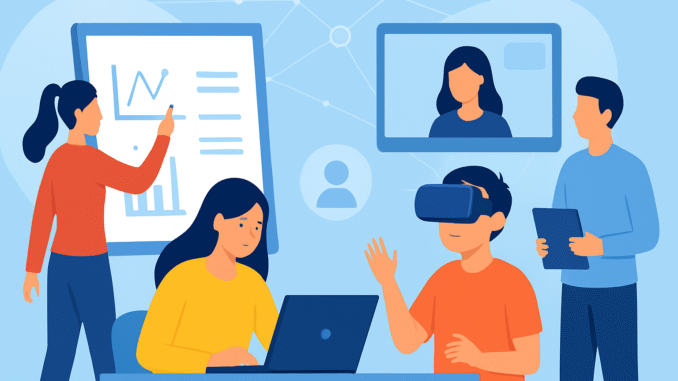
The Future of Learning: How Technology Is Transforming Education in 2025 and Beyond
Education has always been the foundation of human progress, but in 2025, it’s undergoing one of the most significant transformations in history. Driven by artificial intelligence (AI), digital platforms, and global connectivity, technology is reshaping how students learn, teachers teach, and institutions operate. From AI tutors to immersive virtual classrooms, the future of learning is more accessible, personalized, and interactive than ever before.
In this article, we’ll explore how technology is revolutionizing education, the major trends shaping its future, and what to expect in the years ahead.
1. The Rise of Smart Classrooms
Gone are the days when classrooms relied solely on chalkboards and textbooks. In 2025, the smart classroom has become the new norm. Interactive whiteboards, digital projectors, and tablets have turned traditional learning into a dynamic and engaging experience.
Teachers now use smart technologies to monitor student progress in real time. For example, learning management systems (LMS) like Google Classroom and Microsoft Teams Education allow teachers to track attendance, grade assignments instantly, and provide personalized feedback.
Moreover, smart classrooms use data analytics to understand each student’s strengths and weaknesses. If a student struggles with math, the system automatically recommends practice exercises or video tutorials. This adaptive approach ensures that no learner is left behind and that education caters to individual needs.
2. Artificial Intelligence: The New Personal Tutor
AI is no longer science fiction—it’s the driving force behind the new age of education. In 2025, AI-powered learning assistants are becoming as common as textbooks once were.
These AI tutors can personalize lessons, answer questions instantly, and even assess emotional engagement. For instance, AI algorithms analyze how long a student spends on a particular topic and adjust the difficulty level accordingly. This creates a custom learning path that evolves with each student’s progress.
Apps like ChatGPT, Duolingo Max, and Squirrel AI are already using AI to provide personalized tutoring experiences. Students can learn languages, math, or science with AI feedback that adapts to their pace and style.
In addition, teachers are using AI tools to automate administrative tasks such as grading papers and creating lesson plans. This allows educators to spend more time focusing on mentorship, creativity, and emotional support—areas where human connection remains irreplaceable.
3. The Power of Virtual and Augmented Reality in Education
Virtual Reality (VR) and Augmented Reality (AR) are revolutionizing how students experience education. Instead of reading about the solar system, learners can explore it through a VR headset. Instead of memorizing anatomy from a textbook, medical students can use AR to visualize 3D models of the human body in real time.
By 2025, schools and universities around the world have adopted immersive learning technologies. VR field trips take students to historical landmarks, oceans, and even outer space—all without leaving the classroom. This not only makes learning more engaging but also enhances retention and understanding.
AR applications, on the other hand, bring static content to life. Students can scan images in their textbooks to view interactive diagrams, videos, or quizzes. These technologies make abstract concepts tangible and foster a deeper level of curiosity and exploration.
4. Online and Hybrid Learning: The New Normal
The COVID-19 pandemic accelerated the shift toward online education, but what started as a necessity has now become a permanent part of the educational landscape.
In 2025, hybrid learning models—combining in-person and online education—are now standard across many institutions. Students can attend physical classes while also accessing recorded lectures, online discussions, and virtual study groups.
Platforms such as Coursera, Khan Academy, and edX have become global education hubs, offering courses from top universities to anyone with an internet connection. The flexibility of online education allows students to learn at their own pace, whether they’re in a city, a remote village, or halfway across the world.
Additionally, microlearning and bite-sized courses have gained popularity. Learners can complete short, focused lessons on specific topics, making continuous education more achievable for working adults.
5. Data-Driven Education and Learning Analytics
Education in 2025 is not just digital—it’s data-driven. Learning analytics tools collect information about how students interact with course materials, how they perform on assessments, and even how engaged they are during lessons.
This data helps educators make informed decisions. For example, if a class consistently struggles with a particular concept, the system alerts the teacher to revisit the topic or offer additional resources.
Data analytics also helps schools predict student outcomes, prevent dropouts, and design more effective curricula. With data at their fingertips, institutions can ensure that every decision improves the learning experience and student success.
6. Global Access and Inclusion Through Technology
One of the most powerful impacts of educational technology is accessibility. In 2025, millions of students who once lacked access to quality education can now learn online—thanks to affordable devices, internet connectivity, and open educational resources (OER).
Digital platforms have broken down geographical and economic barriers. A student in a developing country can take online classes from Harvard, Oxford, or MIT. Translation tools powered by AI ensure that language is no longer a barrier to learning.
Moreover, assistive technologies are empowering students with disabilities. Speech-to-text software, audio learning tools, and tactile feedback devices allow visually or hearing-impaired students to fully participate in digital learning environments. Technology is making education more inclusive than ever before.
7. Gamification and the Joy of Learning
Another exciting trend shaping education in 2025 is gamification—the use of game elements in learning environments. By incorporating badges, leaderboards, and point systems, educators motivate students to engage more deeply with their studies.
Platforms like Kahoot!, Quizizz, and Classcraft have transformed lessons into interactive games where students compete and collaborate. This approach not only boosts motivation but also enhances problem-solving skills and creativity.
Gamification taps into the natural human desire for achievement and progress. As a result, learning feels less like a chore and more like an adventure.
8. Lifelong Learning and Career Readiness
In today’s fast-changing world, learning doesn’t end with graduation. Technology has turned education into a lifelong journey.
In 2025, professionals are continually upskilling through online platforms, digital certifications, and AI-based career guidance. Automation and AI are creating new industries while replacing old jobs, making adaptability essential.
Educational technology now helps workers identify skill gaps, recommend training programs, and match them with career opportunities. Companies also invest in internal learning platforms to keep their employees future-ready.
The future of education is about more than just academic achievement—it’s about preparing individuals to thrive in an evolving digital economy.
9. Challenges and Ethical Considerations
While technology offers tremendous benefits, it also presents challenges. The digital divide—differences in access to technology and the internet—still affects millions of learners worldwide. Bridging this gap remains a top priority for educators and policymakers.
Privacy and data security are other major concerns. With so much student data being collected, institutions must ensure it’s stored and used responsibly.
Moreover, there’s a risk of over-reliance on technology. Human interaction, empathy, and creativity are essential parts of education that no machine can replace. Striking the right balance between innovation and humanity is key to sustainable educational growth.
10. The Road Ahead: What to Expect Beyond 2025
Looking ahead, the next decade promises even greater innovation in education. We can expect to see advancements such as:
- AI-driven adaptive curricula that adjust in real time to students’ learning patterns.
- Neural learning interfaces that connect brain signals directly with digital content.
- Blockchain-based education systems for secure credential verification.
- Global learning communities that unite students, teachers, and professionals from all corners of the world.
The classroom of the future will not be confined by walls or borders—it will be a limitless ecosystem of learning.
Conclusion
The future of learning is here, and it’s powered by technology. In 2025 and beyond, education will continue to evolve into a personalized, inclusive, and globally connected experience.
Artificial intelligence, virtual reality, data analytics, and online platforms are revolutionizing how knowledge is shared and acquired. While challenges remain, the opportunities are immense.
Ultimately, technology is not replacing teachers or traditional education—it’s enhancing them. The true power of educational innovation lies in its ability to inspire curiosity, foster creativity, and empower learners everywhere to reach their full potential.

